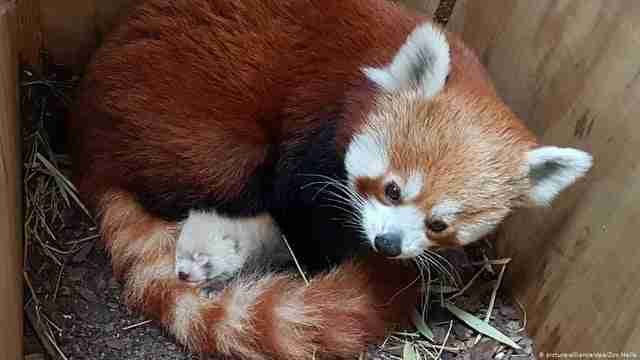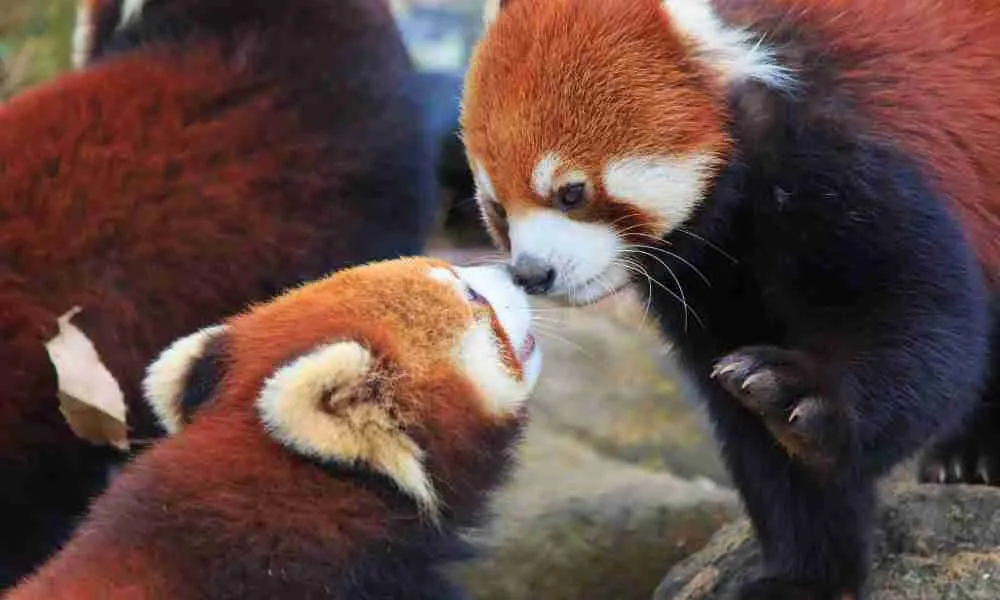Did you know that red panda moms love their babies so much? In fact, female red pandas do all the work themselves without their male support!
Sadly, the rate at which infant red pandas die is high. However, red pandas are remarkably caring enough to help their cubs survive.
And If you’re wondering how they do it, keep your eye glued to this article.
Now, let’s get started!
At Birth

Female red pandas are very protective of their cubs at birth. This care even starts before they give birth.
Pregnant red pandas make necessary preparations when they have just a few days left to give birth. Mothers will create birth dens with hollow trees and stumps.
Additionally, they will include a nest in the den, which they make out of twigs, branches, moss, and leaves. These preparations are to make sure their cubs are born in a comfortable environment.
Though newborn red pandas are born with fur, their moms still protect them from severe colds. And since cubs remain helpless, blind, and deaf for some weeks, they need their moms to survive.
Furthermore, red pandas feed their young only breast milk for a couple of weeks. And the first 7-10 nursing days are usually the most caring and protective period.
0-6 Months
In about a month or two, red panda cubs start to become very active. They begin to explore the den, play and learn to groom themselves.
Red pandas continue to feed milk to their young but will begin to introduce solid food to them. Mothers will go out and fetch tender bamboo twigs for their babies to chew on in the den.
Funnily, the cubs might just do more chewing on bamboo than eating it at first. However, this is how red pandas start to teach their babies the habit of eating bamboo.
Eventually, red panda cubs will get used to eating bamboo. And by the time they are 4 months old, they must have started eating bamboo very well.
Around this time, red pandas also begin to let their cubs explore outside the den. Throughout the nursing period, red pandas can change different birth dens.
They’ll carry their cubs in her mouth and move them from den to den whenever necessary. This is to make sure the cubs are as safe as possible.
Red pandas will continue to nurse their young till about 3 months or 6 months.
6-12 Months
When cubs are six-month-old, they appear almost the size of their moms. Hence, at this age, red pandas don’t see their cubs as babies anymore.
This equally means female red pandas will start to show little care for their young ones that are around this age. This is normal behavior among mammals.
But the good thing is that red pandas prepare their young ones to live in the wild on their own before this time.
This preparation includes teaching the cubs the necessary skills for survival in the wild. See some of these skills below:
- Hunting – comes in handy when red pandas want to try meat.
- Foraging for bamboo – a very important red panda skill
- Sunbathing during winter
12-20 Months
Generally, red pandas stay with their mothers for up to a year or a little longer. Sometimes, female red pandas will stay with their cubs till they get pregnant again.
Furthermore, a red panda aged 12 months or more is mature enough to live on its own. What’s more, female cubs at this age are ready to become mothers.
Hence, this is normally the time red panda moms chase their already mature offspring away. They mostly do it so they can prepare to raise their next cubs.
Recap:
Humans alone aren’t enough to raise a healthy red panda cub. In regards to the way red pandas raise their cubs, here are a few things to remember:
- Expectant red pandas take their time to build comfortable birth dens for their cubs.
- A male red panda doesn’t take part in raising red panda cubs.
- Red panda moms will have to severally move their cubs from den to den to keep them safe.
- Female red pandas prepare their young to face the wild and live on their own.
- Mothers stay with their cubs till they’re mature enough – about a year old.
- Red panda moms are important in raising a very healthy cub.
There’s more to know about the birth of red pandas. Find all your answers in our article – All About Red Panda’s Birth

